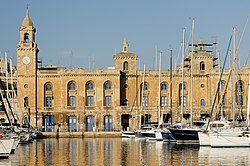Public Force (Montecara): Difference between revisions
No edit summary |
No edit summary |
||
| Line 10: | Line 10: | ||
|commander = {{wp|Captain-General}} Ermàn Manfrìn | |commander = {{wp|Captain-General}} Ermàn Manfrìn | ||
|commander_title = {{wp|Chief of Defense}} | |commander_title = {{wp|Chief of Defense}} | ||
|age = 17 (voluntary) | |age = 17 (voluntary)<br />18 (compulsory) | ||
|conscription = 12 or 18 months | |conscription = 12 or 18 months | ||
|manpower_data = | |manpower_data = | ||
Revision as of 19:38, 30 December 2022
| Public Force | |
|---|---|
| Fòrça Pùblica | |
| borderless | |
| Leadership | |
| Commander-in-Chief | Colegio |
| Secretary of Defense and Security | Tulio Brucàt |
| Chief of Defense | Captain-General Ermàn Manfrìn |
| Personnel | |
| Military age | 17 (voluntary) 18 (compulsory) |
| Conscription | 12 or 18 months |
| Active personnel | 5,655 |
| Reserve personnel | 16,875 |
| Deployed personnel | 0 |
| Expenditure | |
| Budget | $715 million (2021) |
| Percent of GDP | 0.46% (2021) |
| Related articles | |
| History | Template:Blist |
| Ranks | Military ranks of Montecara |
The Public Force (Montecaran: Fòrça Pùblica) is the unified military of Montecara. It consists of the Montecaran Army (Exèrçito Montecarà), Montecaran Navy (Armàda Montecarà), and Montecaran Air Squadron (Scuadrón Aierià Montecarà).
Defense policy
Militarily, Montecara faces several disadvantages. Its small size limits manpower and gives it little strategic depth with which to defend itself. Its strategic location is something of a double-edged sword, increasing the nation's relevance and bargaining power but making it a potential target of external aggression.
The Montecaran government has attempted to compensate for its weaknesses by adopting a military policy based on near-universal conscription, hoping to discourage invaders by promising that they will face a trained and tenacious resistance. Exact defense plans are classified, but it is known that Montecara's military strategy is based first on deterrence and second on organized resistance to invasion. Deterrence rests on making it clear that the attacking force would suffer unacceptable casualties in seeking to capture Montecara's small territory. Failing this, the goal of resistance is to deny the enemy use of the nation's strategic assets and exhaust its will to fight.
Because of its strategic and practical limitations, Montecara has adopted a policy of mitigation it terms "Integral Defense" (Difèsa intèra) which marshals all the resources of the nation to dissuade aggressors. The Montecaran state views such matters as political consensus, administrative competence, economic power, cultural influence, and international relationships as pillars which complement military power in maintaining national security, and makes policy decisions accordingly. This approach also promotes social cohesion by creating an atmosphere in which Montecarans must stand together against a hostile outside world.
Montecara engages in defense cooperation with the other members of the Euclean defense community. Allied ships make regular calls at the Port of Montecara, and the state is protected by the Euclean Community nuclear umbrella.
Organization and manpower
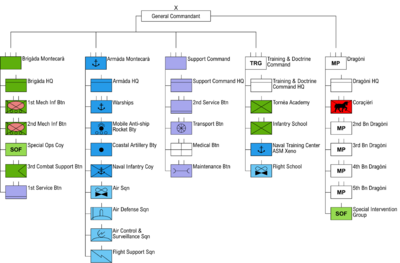
Montecara practices conscription for a term of 18 months usually beginning at graduation from secondary school at age 18. All able-bodied citizens and permanent residents, male and female, are eligible.
New recruits report to the Citadel of Montecara and take a battery of physical and academic tests. Based on their results, they may be assigned to a remedial physical fitness course or move directly on to recruit training. The basic training course lasts 12 weeks, during which recruits learn the rudiments of military skills and discipline.
Once a conscript's term of service is complete, he or she is considered a qualified soldier and remains on the reserve list until reaching the age of 40 (for other ranks) or 45 (for officers).
Armàda
The Armàda is the seaborne and airborne component of the Força pùblica. It is responsible for defending Montecara's territorial waters and exclusive sector in accordance with national and international law. It accordingly conducts operations to safeguard Montecaran sovereignty and the safety of its territory and resources, as well as to support allied forces, search and rescue operations, and maritime law enforcement. The Armàda is an inshore constabulary capable of maritime policing confined well within the state's exclusive sector. The Secretariat of Defense and Security describes its role as a "green-water navy" dedicated to the defense of the state and its immediate territorial waters. It is an entirely professional, volunteer force, and nearly all of its personnel are skilled workers who have highly specialized duties. The Armàda includes a company-sized formation of naval infantry led by a sopracomito (an officer of grade O-3).
Montecara was historically one of the most powerful seagoing states in the world. At its peak around 1500, the Montecaran Navy boasted over 3,000 vessels which were turned out on an industrial scale by its Arsenàl, a fortress and shipbuilding factory that could produce up to a ship a day when working at full capacity. Montecarans were masters of the sail-and-oar ship, basing their designs on naval architecture with a history that stretched back to the Solarian Republic. These vessels, highly maneuverable and with a shallow draft, were ideally suited to navigating the Solarian Sea and allowed Montecarans to acquire far-flung territory as part of their overseas possessions, the Stado Ultramarìn.
Montecaran seafaring prowess was recognized by the Gaullican Empire during its occupation in the nineteenth and early twentieth centuries, with many Montecarans serving in specialized and even command roles in the Gaullican navy. Since the re-establishment of independence, Montecara has maintained a small but well-equipped and well-trained naval force that is focused on guarding the city-state's strategic location and ensuring the flow of trade through the Aurean Straits.
Ranks
Officers
Enlisted
Equipment
Vehicles
| Type | Image | Role | Quantity | Year acquired |
|---|---|---|---|---|
| Armored fighting vehicles | ||||
| Général BC 40 T | 
|
Infantry fighting vehicle | 8 in service | 2006 |
| Fonan E2 | 
|
Light armored car | 4 in service | 2005 |
| Autonomous vehicles | ||||
| DELFIN | 
|
Mine countermeasures / Search and rescue |
1 in service | 2018 |
| ISE Aigle | 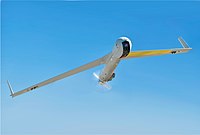
|
Unmanned aerial vehicle | 1 system (4 drones) in service | 2013 |
| Boats | ||||
| GL boat | 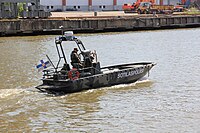
|
Fast boat / Landing craft |
4 in service | 2004 |
| Fixed-wing aircraft | ||||
| IFO Aerocamio | 
|
Maritime patrol aircraft / Military transport aircraft | 3 in service | 1998–1999 |
| Altamecanica Atlante | 
|
Maritime patrol aircraft / Military transport aircraft | 1 in service | 2010 |
| Piàvo 180 | 
|
Maritime patrol aircraft / VIP transport | 1 in service | 1995 |
| RUI T-5 | 
|
Basic trainer | 10 in service | 1988–2002 |
| Ground utility vehicles | ||||
| Éclair Ascension | 
|
Light utility vehicle | 24 in service | 2006–2009 |
| Éclair M 150 | 
|
Heavy cargo truck | ||
| Helicopters | ||||
| HdF 90 | 
|
Anti-submarine warfare | 6 in service | |
| Agùst A109 | 
|
Military utility helicopter | 2 in service | |
Artillery
| Type | Image | Role | Quantity | Year acquired |
|---|---|---|---|---|
| Mortars | ||||
| Mortier Tr. 51 | 
|
107 mm mortar | ||
| Mortier Tr. 78 | 
|
60 mm mortar | ||
| Towed artillery | ||||
| Obusier Tr. 75 | 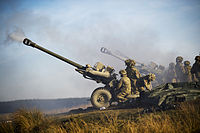
|
105 mm howitzer | 6 in service | |
| Obusier Tr. 205 | 
|
155 mm howitzer | 4 in service | |
| Naval artillery | ||||
| Autotorexìn 13 cm | 
|
Coastal artillery | 6 in service | 1984 |
| MA5 | 
|
Truck-mounted anti-ship missile system | 5 in service | 2009 |
Ships
| Class | Image | Ships | Displacement (tonnes) |
Commissioned | |
|---|---|---|---|---|---|
| Corvettes (1 in service) | |||||
| Triton | 
|
ASM Tritòn | 1,285 | 1995 | |
| Patrol vessels (6 in service) | |||||
| Ligio | 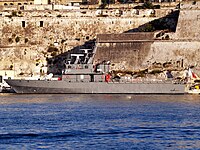
|
ASM Ligio ASM Çenturio ASM Pilo ASM Gladio ASM Lòrica ASM Òptio |
390 | 1993-1996 | |
| Minehunters (2 in service) | |||||
| Xile | 
|
ASM Xile ASM Sirèna |
620 | 1997 | |
| Research vessels (1 in service) | |||||
| Nereida | 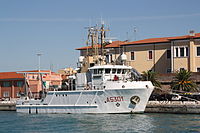
|
ASM Nereida | 433 | 2004 | |
| Tugboats (4 in service) | |||||
| Bigorno | 
|
ASM Bigorno ASM Ciriped ASM Anèmone ASM Nautìl |
412 | 1987-1989 | |
| Transport ships (2 in service) | |||||
| Cerèra | 
|
ASM Cerèra ASM Convèctor |
631 | 1989 | |
| Training ships (1 in service) | |||||
| Xeno | 
|
ASM Xeno | 858 | 1935 | |
Small arms
| Model | Image | Type | Caliber | Notes |
|---|---|---|---|---|
| Handguns | ||||

|
Pistol | 5.7×28mm | Standard-issue pistol | |
| Rifles | ||||
| Assault rifle | 5.56×45mm | Standard-issue rifle | ||
| Battle rifle | 7.62×51mm | Former standard-issue rifle, many still in stock | ||
| File:Scar L Standard.jpg | Assault rifle | 5.56×45mm | In use by select units | |
| Sniper rifle | 8.58×70mm | |||
| Submachine guns | ||||

|
General-purpose submachine gun | 9×19mm | ||
| Machine guns | ||||

|
General-purpose machine gun | 7.62×51mm | ||

|
Heavy machine gun | 12.7×99mm | Used on vehicles and emplacements | |
| Shotguns | ||||
| Shotgun | 12 gauge | |||
| Anti-tank and anti-air weapons | ||||
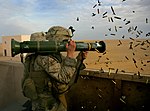
|
Anti-tank weapon | 84 mm | ||

|
Man-portable air-defense system | |||

